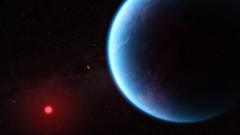In a breakthrough study, researchers at Cambridge University have revealed new evidence suggesting that K2-18b, a planet located over 700 trillion miles away, might harbor life. The team has detected molecules in its atmosphere indicative of biological activity, particularly two chemicals—dimethyl sulphide (DMS) and dimethyl disulphide (DMDS)—which on Earth are linked to simple organisms.
The findings were made possible by NASA's advanced James Webb Space Telescope (JWST), making this the second instance where life-associated chemicals have been spotted on K2-18b's atmosphere. However, scientists underscore the need for further validation before drawing any firm conclusions.
Lead researcher Prof. Nikku Madhusudhan expressed optimism about the potential for confirming these signals within the next one to two years. "This is the strongest evidence yet there is possibly life out there," he stated from his lab at the Cambridge Institute of Astronomy. Due to its substantial size—two and a half times that of Earth—K2-18b’s intricate atmosphere presents unique opportunities to study planetary evolution and the potential for life elsewhere in the universe.
Despite the promising signs, the initial results are only at a confidence level of three sigma (99.7%), short of the five sigma threshold required for definitive scientific claims. Prof. Catherine Heymans, Scotland's Astronomer Royal, emphasized the importance of determining the origin of the detected gases. While both DMS and DMDS are products of marine life on Earth, geological phenomena could also contribute to their presence on K2-18b.
To address these uncertainties, the Cambridge team is conducting laboratory experiments to explore if similar gases could be generated through non-biological processes. Other scientists have proposed alternative theories regarding the planet's atmosphere, with some suggesting the presence of a vast liquid ocean, while others argue for a different planetary composition altogether.
The scientific community remains divided, with ongoing debates about K2-18b's conditions possibly favoring life or barring it altogether. As Prof. Madhusudhan acknowledges, the quest for definitive answers regarding extraterrestrial life remains complex and multifaceted, but he remains hopeful that current research may soon yield groundbreaking insights. The full research is detailed in The Astrophysical Journal Letters, marking a significant chapter in the search for life beyond Earth.








